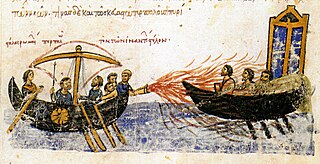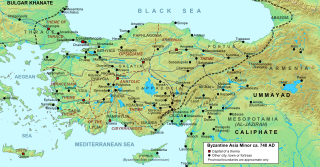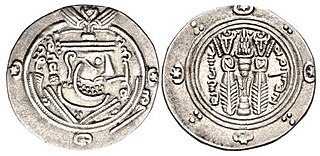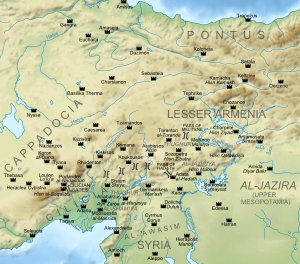
Year 766 (DCCLXVI) was a common year starting on Wednesday of the Julian calendar. The denomination 766 for this year has been used since the early medieval period, when the Anno Domini calendar era became the prevalent method in Europe for naming years.

The Umayyad Caliphate was the second of the four major caliphates established after the death of Muhammad. The caliphate was ruled by the Umayyad dynasty. Uthman ibn Affan, the third of the Rashidun caliphs, was also a member of the clan. The family established dynastic, hereditary rule with Muawiya ibn Abi Sufyan, long-time governor of Greater Syria, who became the sixth caliph after the end of the First Fitna in 661. After Mu'awiyah's death in 680, conflicts over the succession resulted in the Second Fitna, and power eventually fell into the hands of Marwan I from another branch of the clan. Greater Syria remained the Umayyads' main power base thereafter, with Damascus serving as their capital.

The Arab–Byzantine wars were a series of wars between a number of Muslim Arab dynasties and the Byzantine Empire between the 7th and 11th centuries AD. Conflict started during the initial Muslim conquests, under the expansionist Rashidun and Umayyad caliphs, in the 7th century and continued by their successors until the mid-11th century.

The second Arab siege of Constantinople in 717–718 was a combined land and sea offensive by the Muslim Arabs of the Umayyad Caliphate against the capital city of the Byzantine Empire, Constantinople. The campaign marked the culmination of twenty years of attacks and progressive Arab occupation of the Byzantine borderlands, while Byzantine strength was sapped by prolonged internal turmoil. In 716, after years of preparations, the Arabs, led by Maslama ibn Abd al-Malik, invaded Byzantine Asia Minor. The Arabs initially hoped to exploit Byzantine civil strife and made common cause with the general Leo III the Isaurian, who had risen up against Emperor Theodosius III. Leo, however, tricked them and secured the Byzantine throne for himself.

The Battle of Akroinon was fought at Akroinon or Akroinos in Phrygia, on the western edge of the Anatolian plateau, in 740 between an Umayyad Arab army and the Byzantine forces. The Arabs had been conducting regular raids into Anatolia for the past century, and the 740 expedition was the largest in recent decades, consisting of three separate divisions. One division, 20,000 strong under Abdallah al-Battal and al-Malik ibn Shu'aib, was confronted at Akroinon by the Byzantines under the command of Emperor Leo III the Isaurian r. 717–741) and his son, the future Constantine V. The battle resulted in a decisive Byzantine victory. Coupled with the Umayyad Caliphate's troubles on other fronts and the internal instability before and after the Abbasid Revolt, this put an end to major Arab incursions into Anatolia for three decades.

Khalid ibn Barmak was the first prominent member of the Barmakids, an important Buddhist family from Balkh, which converted to Islam and became prominent members of the Abbasid court in the second half of the 8th century. Khalid himself converted to Islam at the Umayyad court in the 720s, but joined the nascent Abbasid revolutionary movement in Khurasan, and played a significant role in the Abbasid Revolution that toppled the Umayyads. He enjoyed close relations with the first Abbasid caliph, al-Saffah, functioning as his chief minister and introducing innovations in record-keeping. Under al-Saffah's successor, al-Mansur, Khalid's influence decreased, but he still occupied significant provincial governorships in Fars, Tabaristan, and Mosul. As an administrator, he distinguished himself for his fairness, especially in matters of taxation, and was a popular governor. He appears to have briefly fallen into disgrace around 775, but he managed to recover, helped by the rapid rise of his son, Yahya. Khalid's ties to the Abbasid dynasty were soon strengthened when his grandson, al-Fadl ibn Yahya, became the foster-brother of the future caliph Harun al-Rashid, while Yahya became the prince's tutor. Khalid died in 781/2, shortly after returning from an expedition against the Byzantine Empire.

The first Arab siege of Constantinople in 674–678 was a major conflict of the Arab–Byzantine wars, and the first culmination of the Umayyad Caliphate's expansionist strategy towards the Byzantine Empire, led by Caliph Mu'awiya I. Mu'awiya, who had emerged in 661 as the ruler of the Muslim Arab empire following a civil war, renewed aggressive warfare against Byzantium after a lapse of some years and hoped to deliver a lethal blow by capturing the Byzantine capital, Constantinople.

The Muslim conquest of Sicily began in June 827 and lasted until 902, when the last major Byzantine stronghold on the island, Taormina, fell. Isolated fortresses remained in Byzantine hands until 965, but the island was henceforth under Muslim rule until conquered in turn by the Normans in the 11th century.

The Battle of Krasos was a battle in the Arab–Byzantine Wars that took place in August 804, between the Byzantines under Emperor Nikephoros I and an Abbasid army under Ibrahim ibn Jibril. Nikephoros' accession in 802 resulted in a resumption of warfare between Byzantium and the Abbasid Caliphate. In late summer 804, the Abbasids had invaded Byzantine Asia Minor for one of their customary raids, and Nikephoros set out to meet them. He was surprised, however, at Krasos and heavily defeated, barely escaping with his own life. A truce and prisoner exchange were afterwards arranged. Despite his defeat, and a massive Abbasid invasion the next year, Nikephoros persevered until troubles in the eastern provinces of the Caliphate forced the Abbasids to conclude a peace.

The Anatolic Theme, more properly known as the Theme of the Anatolics, was a Byzantine theme in central Asia Minor. From its establishment, it was the largest and senior-most of the themes, and its military governors (stratēgoi) were powerful individuals, several of them rising to the imperial throne or launching failed rebellions to capture it. The theme and its army played an important role in the Arab–Byzantine wars of the 7th–10th centuries, after which it enjoyed a period of relative peace that lasted until its conquest by the Seljuk Turks in the late 1070s.
Michael Lachanodrakon was a distinguished Byzantine general and fanatical supporter of Byzantine Iconoclasm under Emperor Constantine V. As a result of his iconoclast zeal, in 766 he rose to high office as governor of the Thracesian Theme, and instigated a series of repressive measures against iconophile practices, particularly targeting the monasteries. A talented general, he also led a series of campaigns against the Arabs of the Abbasid Caliphate before being dismissed from office in about 782. Restored to imperial favour in 790, he fell at the Battle of Marcellae against the Bulgars in 792.
Al-ʿAwāṣim was the Arabic term used to refer to the Muslim side of the frontier zone between the Byzantine Empire and the Umayyad and Abbasid Caliphates in Cilicia, northern Syria and Upper Mesopotamia. It was established in the early 8th century, once the first wave of the Muslim conquests ebbed, and lasted until the mid-10th century, when it was overrun by the Byzantine advance. It comprised the forward marches, comprising a chain of fortified strongholds, known as al-thughūr, and the rear or inner regions of the frontier zone, which was known as al-ʿawāṣim proper. On the Byzantine side, the Muslim marches were mirrored by the institution of the kleisourai districts and the akritai border guards.

The siege of Nicaea of 727 was an unsuccessful attempt by the Umayyad Caliphate to capture the Byzantine city of Nicaea, the capital of the Opsician Theme. Ever since its failure to capture the Byzantine Empire's capital, Constantinople, in 717–718, the Caliphate had launched a series of raids into Byzantine Asia Minor. In 727, the Arab army, led by one of the Caliph's sons, penetrated deep into Asia Minor, sacked two Byzantine fortresses and in late July arrived before Nicaea. Despite constant attacks for 40 days, the city held firm and the Arabs withdrew and returned to the Caliphate. The successful repulsion of the attack was a major boost for Byzantine emperor Leo III the Isaurian's recently initiated campaign to abolish the veneration of icons in the Empire; Leo claimed it as evidence of divine favour for his policy. The siege of Nicaea marks also the high point of the Umayyad raids, as new threats and defeats on their far-flung frontiers decreased Umayyad strength elsewhere, while Byzantine power strengthened afterwards.

The siege of Tyana was carried out by the Umayyad Caliphate in 707–708 or 708–709 in retaliation for a heavy defeat of an Umayyad army under Maimun the Mardaite by the Byzantine Empire in c. 706. The Arab army invaded Byzantine territory and laid siege to the city in summer 707 or 708. The date is uncertain, as virtually each of the extant Greek, Arabic, and Syriac parallel sources has in this respect a different date. Tyana initially withstood the siege with success, and the Arab army faced great hardship during the ensuing winter and was on the point of abandoning the siege in spring, when a relief army sent by Emperor Justinian II arrived. Quarrels among the Byzantine generals, as well as the inexperience of a large part of their army, contributed to a crushing Umayyad victory. Thereupon the inhabitants of the city were forced to surrender. Despite the agreement of terms, the city was plundered and largely destroyed, and according to Byzantine sources its people were made captive and deported, leaving the city deserted.

The Battle of Kopidnadon or Kopidnados took place in September 788 between the armies of the Abbasid Caliphate and the Byzantine Empire. The Abbasid army launched an invasion of Byzantine Asia Minor, and was confronted by a Byzantine force at Kopidnadon. The resulting battle was an Abbasid victory. Among the Byzantine losses was a certain Diogenes, who is identified by some scholars with the probable original source for the literary hero Digenes Akritas.

The Abbasid invasion of Asia Minor in 782 was one of the largest operations launched by the Abbasid Caliphate against the Byzantine Empire. The invasion was launched as a display of Abbasid military might in the aftermath of a series of Byzantine successes. Commanded by the Abbasid heir-apparent, the future Harun al-Rashid, the Abbasid army reached as far as Chrysopolis, across the Bosporus from the Byzantine capital, Constantinople, while secondary forces raided western Asia Minor and defeated the Byzantine forces there. As Harun did not intend to assault Constantinople and lacked ships to do so, he turned back.

The Abbasid invasion of Asia Minor in 806 was the largest of a long series of military operations launched by the Abbasid Caliphate against the Byzantine Empire. The expedition took place in southeastern and central Asia Minor, where the Abbasid and Byzantine empires shared a long land border.
Al-Hasan ibn Qahtaba ibn Shabib al-Ta'i was a senior military leader in the early Abbasid Caliphate.
Yazid ibn Asid ibn Zafir al-Sulami or Yazid ibn Usayd ibn Zafir al-Sulami was an Arab general and governor in the service of the early Abbasid Caliphate. He was active mostly in the Caliphate's northwestern frontier region, serving as governor of Arminiya and the Jazira and fighting against the Byzantine Empire and the Khazars.
Rustam ibn Baradu or Rustum ibn Bardu, surnamed al-Farghani, was a military commander for the Abbasid Caliphate and the governor (wali) of Tarsus from August 905 to 912/3.










